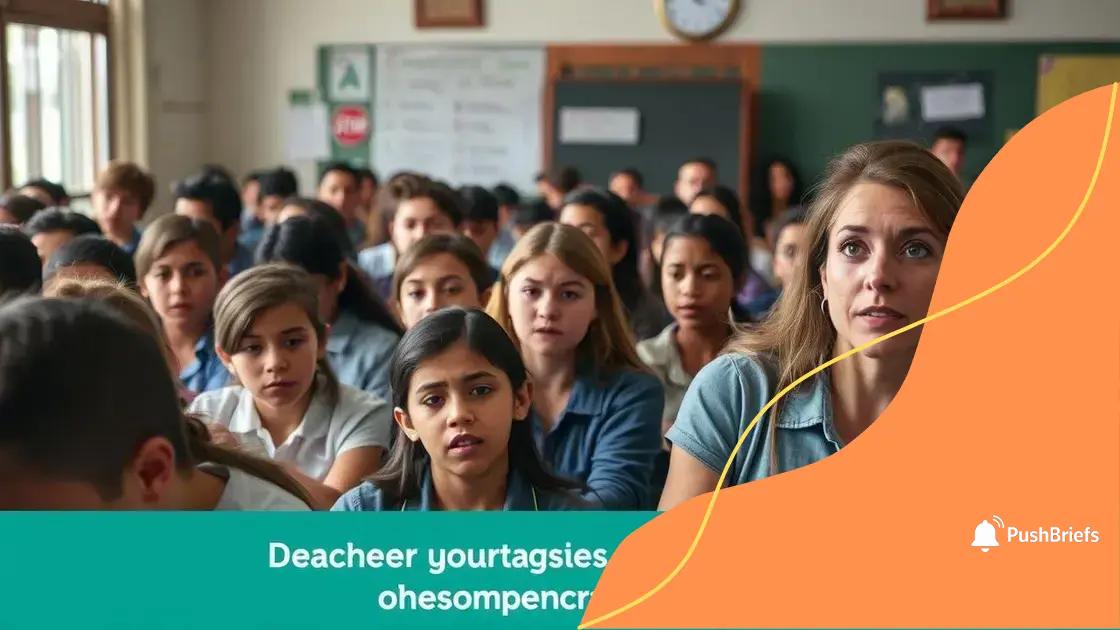Teacher shortages impacting schools: a pressing issue

Teacher shortages negatively impact education by leading to overcrowded classrooms, lack of qualified educators, and diminished student learning outcomes, which necessitates immediate community and policy action to address the crisis.
Teacher shortages impacting schools is a growing concern that affects students’ education across the country. Have you ever wondered how this crisis shapes the classroom experience? Let’s dive into the issue and its implications.
Understanding the scope of teacher shortages
Understanding the scope of teacher shortages is essential to grasping how this issue affects education today. As many schools struggle to find qualified educators, the ripple effects touch every aspect of student learning and school operation.
The Current State of Teacher Shortages
Research indicates that teacher shortages are not just local phenomena; they’re widespread, impacting urban and rural areas alike. School districts face difficulty in recruiting and retaining educators, leading to classrooms that are often overcrowded or lacking sufficient support.
Key Factors Contributing to the Problem
There are several reasons for these shortages, including:
- Low salaries that do not reflect the demand for qualified teachers
- High levels of teacher burnout and stress
- Insufficient support for new teachers leading to early resignation
- Declining enrollment in teacher preparation programs
Each of these factors creates a cycle that makes it challenging to improve the situation. For instance, as teachers leave the profession, remaining teachers often have to take on more responsibilities, increasing their workload and stress.
The Impact on Education
The consequences are profound. Students in classes without experienced teachers may struggle to meet learning standards. This is particularly concerning in critical subjects like math, science, and literacy, where skilled instruction is vital. Furthermore, the anxiety stemming from teacher shortages can affect school culture and overall morale.
Moreover, it’s not solely students who suffer; schools face challenges in maintaining a stable educational environment, which can lead to lower school ratings and community dissatisfaction.
Addressing teacher shortages is not just about hiring more teachers; it encompasses creating a supportive atmosphere that fosters retention and job satisfaction.
Factors contributing to teacher shortages
Several factors are contributing to the ongoing teacher shortages seen in schools today. Recognizing these elements is crucial to understanding how to address the issue effectively.
Low Salaries
One major reason for teacher shortages is the low salaries offered to educators. Many teachers find that their pay does not match the demands of the job, which can lead to feelings of undervalue. This reality encourages many skilled professionals to seek opportunities in other fields where they can earn more and still make an impact.
High Burnout Rates
Teacher burnout is another significant factor. The pressures of managing large classes, meeting diverse student needs, and dealing with administrative tasks can be overwhelming. As a result, many teachers experience stress and exhaustion, which leads to early resignation from the profession.
Inadequate Support for New Teachers
New teachers often face a steep learning curve, yet many school districts provide limited support. Without proper mentorship and resources, many novice teachers struggle to adapt, causing them to leave the profession prematurely. This lack of support can create a cycle of attrition that exacerbates the current shortages.
- Mentorship programs to guide new educators
- Increased professional development opportunities
- Improved working conditions
The declining enrollment in teacher preparation programs is yet another concern. Fewer individuals are pursuing degrees in education, which directly impacts the number of qualified teachers entering the workforce. This is often tied to negative perceptions of the teaching profession and insufficient incentives to encourage new talents.
As these issues continue to intertwine, they create an environment where teacher shortages thrive, making it increasingly vital for schools and communities to take action.
Impact on student learning and school environment

The impact of teacher shortages on student learning and the school environment is profound. When teachers are in short supply, the quality of education can suffer significantly.
Effects on Classroom Dynamics
Classrooms often become overcrowded as schools attempt to accommodate students with fewer teachers. This results in less individual attention for each child. Students may feel lost in the crowd, making it harder for them to engage and participate. Additionally, underqualified teachers may fill gaps, which can hinder the learning process.
Decline in Academic Performance
Research shows that when students are taught by less experienced educators, their academic performance may decline. Lack of effective instructional strategies can keep students from mastering essential skills. The absence of consistent, knowledgeable teachers means that students lose out on valuable learning experiences.
- Increased dropout rates
- Lower test scores
- Difficulty grasping complex subjects
Furthermore, the emotional and social development of students can also be affected. When students perceive a lack of stability within their school environment, they may experience increased anxiety and stress. This can lead to behavioral issues, disrupting the overall learning atmosphere.
As teachers leave the profession, the school culture can suffer. Schools may struggle to create a supportive and positive environment, affecting both students and staff. Teacher shortages lead to a cycle of challenges that can diminish the educational experience for everyone involved.
Potential solutions and preventive measures
Addressing the issue of teacher shortages requires a multi-faceted approach. Schools and communities must work together to implement effective solutions and preventive measures.
Increased Teacher Salaries
One essential step is to offer competitive salaries for teachers. By prioritizing teacher pay, school districts can attract and retain talented educators. Higher salaries can also motivate existing teachers to stay in the profession instead of seeking higher-paying jobs elsewhere.
Support and Resources for Teachers
Providing adequate support for teachers is vital. Schools can implement mentorship programs where experienced teachers guide newcomers through their first year. This support helps new educators feel more confident and reduces early attrition rates.
Improving Work Environments
Creating a positive school environment is another key aspect. Schools should focus on reducing administrative burdens on teachers and providing them with the resources they need to succeed. This includes smaller class sizes, access to teaching aids, and professional development opportunities.
- Flexible work schedules for better work-life balance
- Access to mental health resources
- Regular feedback and recognition for hard work
Engaging the community can also play a significant role. Schools can partner with local organizations to promote the teaching profession and share its importance. Public campaigns that highlight successful teaching stories can inspire more individuals to consider a career in education.
Furthermore, enhancing teacher preparation programs can lead to better training of future educators. Collaboration between universities and school districts can ensure that new teachers are well-equipped to face the challenges in today’s classrooms.
The role of community in addressing shortages
The involvement of the community is crucial in addressing teacher shortages in schools. When communities actively participate, they can create a supportive environment that encourages teachers and enhances students’ educational experiences.
Building Awareness
One of the first steps communities can take is to raise awareness about the realities of teacher shortages. Local organizations can host events that inform the public about the challenges teachers face and the importance of having qualified educators in every classroom. Sharing success stories about local teachers can also inspire future educators.
Supporting Local Schools
Communities can support their local schools in various ways. Volunteering in classrooms, organizing fundraising events, and providing resources can help alleviate some of the burdens that schools face due to teacher shortages. Engaged parents and community members can work together to create programs that offer enrichment activities, helping to fill gaps left by a shortage of teachers.
- Establishing tutoring programs that offer academic support
- Creating mentorship opportunities for new teachers
- Developing partnerships with local businesses to provide materials and resources
Furthermore, advocating for policy changes at the local and state levels can make a big difference. Communities can unite to lobby for increased funding for education, better salaries for teachers, and improved teacher training programs. When community members voice their concerns and support changes, they can influence positive outcomes.
Additionally, forming strong connections between schools and local colleges or universities can help. These institutions can host workshops and internships that encourage students to pursue careers in education. By fostering a pipeline of new teachers, communities can actively combat the teacher shortages they face.
FAQ – Frequently Asked Questions about Teacher Shortages
What are the main causes of teacher shortages?
The main causes include low salaries, high burnout rates, inadequate support for new teachers, and declining enrollment in teacher preparation programs.
How do teacher shortages impact student learning?
Teacher shortages can lead to overcrowded classrooms, less individual attention for students, and a decline in academic performance.
What solutions can communities implement to support teachers?
Communities can increase teacher salaries, provide mentorship programs, support local schools through volunteering, and advocate for policy changes.
Why is community involvement important in addressing teacher shortages?
Community involvement helps raise awareness, provides additional resources, and fosters a supportive environment for teachers and students alike.
